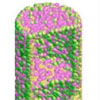| Apr 29, 2022 |
|
(Nanowerk News) Self-supporting electrode material without binder exhibits better energy storage capacity and better stability than conventional powder electrodes because of its lower electrical resistance.
|
|
Among various metallic compositions with pseudocapacitive properties, Ni and Co compounds, including their (hydro)oxides, sulfides and phosphides, are highly theoretical due to their transition from Ni and Co atoms of different valence states attention has been paid to capacitance.
|
|
Professor Hui Wang and co-workers from the School of Chemical Engineering at Qingdao University of Science and Technology obtained NiCoP electrode materials with high specific capacity by doping phosphorus element into nickel-cobalt-based electrode materials. This research was published online in Frontiers of Chemical Science and Engineering (“Engineering the grain boundary: a promising strategy to configure NiCoP4O12/NiCoP nanowire arrays for ultra-stable supercapacitor”).
|
|
The grain boundary-rich NiCoP4O12/NiCoP electrode material was prepared by a three-step method. Firstly, the precursor of nickel and cobalt was prepared by simple hydrothermal treatment, followed by one-step heat treatment, which was converted into oxide of nickel and cobalt, and finally the composite material of phosphide was obtained by vapor deposition method. By changing the phosphating time, different grain boundaries could be obtained.
|
|
In the three-step synthesis study, the researchers studied the structure, morphology and electrochemical properties of the samples through a series of related physical characterizations and electrochemical performance tests, and successfully confirmed the preparation of nanostructures stacked by crystal grains.
|
|
The line array structure was studied, and the key to improving the performance was that the rich grain boundary density greatly increased the active sites of the electrode material, resulting in a greatly improved electrochemical performance of the material.
|
|
The final research results show that the nickel-cobalt-based electrode material doped with phosphorus has a high specific capacitance of 507.8 µAh·cm−2 at 1 mA·cm−2 due to phosphorus doping and rich grain boundary density, and realizes 88.5% ultra-stable ability after 10 000 cycles.
|
|
This design of abundant grain boundaries within the cell is an interesting strategy to achieve higher active site densities. In addition, the electronic structure of the grain boundaries is also tuned compared to the in-plane active sites, which promotes the activity of the array electrodes. The development of grain boundary-rich arrays is another innovative direction for the improvement of electrochemical capacitors.
|
